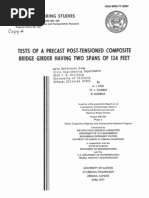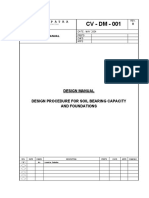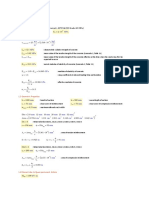Section Design For Crack Width
Uploaded by
You TubeSection Design For Crack Width
Uploaded by
You TubeSection Design for Crack width
The Section Design for Crack width can be used to design reinforced concrete sections to
meet specific crack requirements. Both beam and slab sections can be designed for the
combined effects of axial tension, bending moment and temperature.
Section Design for Crack width 6-185
Theory and application
The following text gives an overview of the application of the theory.
Design scope
The program can determine reinforcement layouts to contain cracks. Both rectangular beam
and slab sections can be designed to resist the effects of axial tension, bending moment and
temperature and the combination thereof. Temperature effects are also included to evaluate
early cracking and long-term thermal cracking.
Shrinkage
Concrete shrinkage due to hydration is accounted for by a combination of the thermal
expansion coefficient and the restraint factor. The design method employed by the codes is
ideally suited for non-temperate regions like Europe.
Reinforcement type
Concrete cracking has traditionally been correlated with the prevailing tensile steel stress.
Eurocode 2 - 1984 also takes account of the type of reinforcement, i.e. bond between concrete
and reinforcement.
Codes of practice
Design calculations are done according to BS 8007 - 1987 and Eurocode 2 - 1992.
Units of measurement
Both Metric and Imperial units of measurement are supported.
List of symbols
The design code symbols are used as far as possible:
Section dimensions
bt : Width of the section (mm or in).
h : Overall height of the section (mm or in).
he : Effective surface zone depth (mm or in).
Material properties
fcu : Concrete cube strength (MPa or psi).
6-186 Section Design for Crack width
fy : Main reinforcement yield strength (MPa or psi).
Applied loads
R : Restraint factor.
T1 : Hydration temperature difference (°C).
T2 : Seasonal temperature variation (°C).
: Thermal expansion coefficient of concrete (m/m per °C or in/in per °C).
TSLS : The tensile force on the full section at serviceability limit state (kN or kip).
TULS : The tensile force on the full section at ultimate limit state. (kN or kip).
MSLS : Serviceability limit state moment (kNm or kipft).
MULS : Ultimate limit state moment (kNm or kipft).
Ro critical : The minimum percentage of reinforcement to be supplied.
Design output
Ast : Area of suggested reinforcement layout. (mm² or in²).
fst : Tensile stress in reinforcement (MPa or psi).
Mu : Ultimate moment capacity of section (kNm or kipft).
TU : Ultimate tensile capacity of surface zone (kN or kip).
Section Design for Crack width 6-187
Input
The section geometry and loading is entered using the single input table. The following points
require special attention.
The program evaluates an effective surface zone where crack control would be effective,
rather than the complete section. The surface zone is normally entered as half the section
depth but not more than 250 mm.
Because only a surface zone is considered, only half of the entered tensile forces
(applicable to the overall section) is used.
Reinforcement is calculated for the surface zone. The same reinforcement should be
supplied in full in both faces of the section.
Eurocode 2 requires additional information regarding the type of reinforcement bond
applicable i.e. high-bond or plain bars.
Select Beam mode if you wish cracking to be evaluated at the section corners as well.
Tip: It is recommended that wide sections be designed using Slab mode.
6-188 Section Design for Crack width
The hydration temperature, T1, is defined as the difference between the environmental
temperature and the peak temperature due to hydration. The value is used to evaluate early
thermal cracking. Typical values, taken from Table A.2 of the code, are given below.
OPC content (kg/m3)
Section 325 350 400 325 350 400
Thickness (mm) Steel formwork 18 mm plywood formwork
300 11* 13* 15* 23 25 31
500 20 22 27 32 35 43
700 28 32 39 38 42 49
1000 38 42 49 42 47 56
* Generally a minimum value of 20°C should be used.
The seasonal temperature variation, T2, is used to calculate long term thermal cracking:
If movement joints are provided as per Table 5.1 of the code, the seasonal variation
can normally be set equal to zero when considering early cracking only.
The seasonal temperature variation should always be considered for long-term thermal
cracking in combination with the applied moments and tensile forces.
Section OPC content (kg/m3)
Thickness (mm) 325 350 400
300 15 17 21
500 25 28 34
The restraint factor describes the amount of restraint in the system. The factor varies
between 0.0 to 0.5. For more detail, refer to Figure A3 of the code.
Tip: A higher restraint factor generally gives rise to more severe cracking. Therefore, when
in doubt, use a restraint factor of 0.5.
Enter a value for Ro critical, i.e. the minimum percentage of reinforcement to be supplied.
The value applies to the gross concrete section of the surface zone. The program gives a
default value of 100 · fct / fy, where fct is the three-day tensile strength of the immature
concrete. For more detail, refer to paragraph A.2 of the code.
Section Design for Crack width 6-189
Design
The following checks are considered for each load case at serviceability limit state:
The combined effect of bending moment, tensile force and the seasonal temperature
variation, i.e. MSLS + TSLS + T2.
Early thermal movement, T1 only.
Early thermal movement and seasonal variation combined, i.e. T1 + T2.
The section is also evaluated at ultimate limit state by considering the combined effect of
bending moment and tensile force, i.e. MULS + TULS.
Up to four sets of bars are calculated for slab sections. Each set has a different diameter and
spacing to comply with the crack width requirements. A fifth column is provided where you
could enter a bar configuration of choice.
For beams, up to four sets of bars are calculated. Each set of bars consists of a number of bars
of not more than two different diameters. The bar diameters are chosen to not differ by more
than one size.
6-190 Section Design for Crack width
Calcsheets
The crack width design output can be grouped on a calcsheet for printing or sending to
Calcpad. Various settings can be made with regards to the inclusion of design results and
pictures.
Tip: You can embed the Data File in the calcsheet for easy recalling from Calcpad.
Recalling a data file
If you enable the Data File option before sending a calcsheet to Calcpad, you can later recall it
by double-clicking the relevant object in Calcpad. A data file embedded in Calcpad is saved
as part of a project and therefore does not need to be saved in the design module as well.
Section Design for Crack width 6-191
6-192 Section Design for Crack width
You might also like
- Chapter One: Structural Design (Introduction, Materials and Design Concepts)No ratings yetChapter One: Structural Design (Introduction, Materials and Design Concepts)61 pages
- NCh2369.Of2003 (English April 25 2005) Seismic Design of Industrial Struct and FacilNo ratings yetNCh2369.Of2003 (English April 25 2005) Seismic Design of Industrial Struct and Facil131 pages
- Lecture 3 Bending and Shear in Beams PHG A8 2oct16No ratings yetLecture 3 Bending and Shear in Beams PHG A8 2oct1630 pages
- App12 - ACI Meshed Slab and Wall DesignNo ratings yetApp12 - ACI Meshed Slab and Wall Design51 pages
- Crack Width Calculations According To Eurocode 2No ratings yetCrack Width Calculations According To Eurocode 23 pages
- EUROCODE 2 - Crack Calculations (Doubly Reinforced)No ratings yetEUROCODE 2 - Crack Calculations (Doubly Reinforced)3 pages
- A Necessary Change in The Seismic Design Provisions of The 2000 IbcNo ratings yetA Necessary Change in The Seismic Design Provisions of The 2000 Ibc10 pages
- Modelling Soil Stiffness As Spring Support: Thread507-263600No ratings yetModelling Soil Stiffness As Spring Support: Thread507-2636003 pages
- Validation Flexible Tank Foundation On Elastic Saturated Soil 2016No ratings yetValidation Flexible Tank Foundation On Elastic Saturated Soil 20164 pages
- Fcu Footing 30 Mpa: Determination of Resultant Force LocationNo ratings yetFcu Footing 30 Mpa: Determination of Resultant Force Location7 pages
- Materials Engineering: Pangasinan State University Urdaneta Campus Mechanical Engineering DepartmentNo ratings yetMaterials Engineering: Pangasinan State University Urdaneta Campus Mechanical Engineering Department7 pages
- BY Pooja Pingle: Structwel Designers & ConsultantsNo ratings yetBY Pooja Pingle: Structwel Designers & Consultants23 pages
- Design of Two Way Slabs: ItisatwowayslabNo ratings yetDesign of Two Way Slabs: Itisatwowayslab9 pages
- Design of Rectangular RC Beams With Known DimensionsNo ratings yetDesign of Rectangular RC Beams With Known Dimensions6 pages
- Escaped: Stresses Beneath Pads Under Eccentric Loads, Shears and MomentsNo ratings yetEscaped: Stresses Beneath Pads Under Eccentric Loads, Shears and Moments19 pages
- "Anchor Reinf." - Anchor Reinforcement Analysis: Program DescriptionNo ratings yet"Anchor Reinf." - Anchor Reinforcement Analysis: Program Description6 pages
- Two Dimensional Truss: Practical No.-01No ratings yetTwo Dimensional Truss: Practical No.-0168 pages
- 2010 Nonlinear FE Analysis of FRC Floor Diaphragms Undergoing Horizontal Seismic ActionsNo ratings yet2010 Nonlinear FE Analysis of FRC Floor Diaphragms Undergoing Horizontal Seismic Actions6 pages
- 4 Elastic Modulus and Strength of Hollow Concrete Block Masonry With Refrence To The Effect of Lateral Ties0% (1)4 Elastic Modulus and Strength of Hollow Concrete Block Masonry With Refrence To The Effect of Lateral Ties10 pages
- Cracking in Concrete Structures - Calculation of Crack Width and Crack SpacingNo ratings yetCracking in Concrete Structures - Calculation of Crack Width and Crack Spacing48 pages
- Local-political-change--the-neo-creative-city-paradigm-an_2023_City--CultureNo ratings yetLocal-political-change--the-neo-creative-city-paradigm-an_2023_City--Culture10 pages
- 13.0 Cracking Rules For Slab: D, Where BNo ratings yet13.0 Cracking Rules For Slab: D, Where B1 page
- Challenges and Opportunities For Higher Education Amid The COVID19 PandemicNo ratings yetChallenges and Opportunities For Higher Education Amid The COVID19 Pandemic5 pages
- A Study of Partial Replacement of Cement With Palm Oil Fuel Ash in Concrete ProductionNo ratings yetA Study of Partial Replacement of Cement With Palm Oil Fuel Ash in Concrete Production14 pages
- Design For Static Loading: Example: Impact Load, Suddenly Applied LoadNo ratings yetDesign For Static Loading: Example: Impact Load, Suddenly Applied Load11 pages
- Code Requirements For Determining Fire Resistance of Concrete and Masonry Construction Assemblies100% (1)Code Requirements For Determining Fire Resistance of Concrete and Masonry Construction Assemblies32 pages
- A Study On Properties of Reactive Powder Concrete: Sarika SNo ratings yetA Study On Properties of Reactive Powder Concrete: Sarika S4 pages
- N02 336 Fibre-Adhesion Free: Various Processings 002-En Page 1/2No ratings yetN02 336 Fibre-Adhesion Free: Various Processings 002-En Page 1/22 pages
- Test Study On The Fatigue Performance of HSS For Steel WheelsNo ratings yetTest Study On The Fatigue Performance of HSS For Steel Wheels4 pages
- Metric Steel Bolts, Screws and Studs - Proof and Tensile StrengthNo ratings yetMetric Steel Bolts, Screws and Studs - Proof and Tensile Strength2 pages
- Perbaikan Dan Perkuatan Balok Beton Bertulang Dengan Cara Penambahan Profil Baja KanalNo ratings yetPerbaikan Dan Perkuatan Balok Beton Bertulang Dengan Cara Penambahan Profil Baja Kanal10 pages
- Chapter One: Structural Design (Introduction, Materials and Design Concepts)Chapter One: Structural Design (Introduction, Materials and Design Concepts)
- NCh2369.Of2003 (English April 25 2005) Seismic Design of Industrial Struct and FacilNCh2369.Of2003 (English April 25 2005) Seismic Design of Industrial Struct and Facil
- Lecture 3 Bending and Shear in Beams PHG A8 2oct16Lecture 3 Bending and Shear in Beams PHG A8 2oct16
- EUROCODE 2 - Crack Calculations (Doubly Reinforced)EUROCODE 2 - Crack Calculations (Doubly Reinforced)
- A Necessary Change in The Seismic Design Provisions of The 2000 IbcA Necessary Change in The Seismic Design Provisions of The 2000 Ibc
- Modelling Soil Stiffness As Spring Support: Thread507-263600Modelling Soil Stiffness As Spring Support: Thread507-263600
- Validation Flexible Tank Foundation On Elastic Saturated Soil 2016Validation Flexible Tank Foundation On Elastic Saturated Soil 2016
- Fcu Footing 30 Mpa: Determination of Resultant Force LocationFcu Footing 30 Mpa: Determination of Resultant Force Location
- Materials Engineering: Pangasinan State University Urdaneta Campus Mechanical Engineering DepartmentMaterials Engineering: Pangasinan State University Urdaneta Campus Mechanical Engineering Department
- BY Pooja Pingle: Structwel Designers & ConsultantsBY Pooja Pingle: Structwel Designers & Consultants
- Design of Rectangular RC Beams With Known DimensionsDesign of Rectangular RC Beams With Known Dimensions
- Escaped: Stresses Beneath Pads Under Eccentric Loads, Shears and MomentsEscaped: Stresses Beneath Pads Under Eccentric Loads, Shears and Moments
- "Anchor Reinf." - Anchor Reinforcement Analysis: Program Description"Anchor Reinf." - Anchor Reinforcement Analysis: Program Description
- 2010 Nonlinear FE Analysis of FRC Floor Diaphragms Undergoing Horizontal Seismic Actions2010 Nonlinear FE Analysis of FRC Floor Diaphragms Undergoing Horizontal Seismic Actions
- 4 Elastic Modulus and Strength of Hollow Concrete Block Masonry With Refrence To The Effect of Lateral Ties4 Elastic Modulus and Strength of Hollow Concrete Block Masonry With Refrence To The Effect of Lateral Ties
- Cracking in Concrete Structures - Calculation of Crack Width and Crack SpacingCracking in Concrete Structures - Calculation of Crack Width and Crack Spacing
- Local-political-change--the-neo-creative-city-paradigm-an_2023_City--CultureLocal-political-change--the-neo-creative-city-paradigm-an_2023_City--Culture
- Challenges and Opportunities For Higher Education Amid The COVID19 PandemicChallenges and Opportunities For Higher Education Amid The COVID19 Pandemic
- A Study of Partial Replacement of Cement With Palm Oil Fuel Ash in Concrete ProductionA Study of Partial Replacement of Cement With Palm Oil Fuel Ash in Concrete Production
- Design For Static Loading: Example: Impact Load, Suddenly Applied LoadDesign For Static Loading: Example: Impact Load, Suddenly Applied Load
- Code Requirements For Determining Fire Resistance of Concrete and Masonry Construction AssembliesCode Requirements For Determining Fire Resistance of Concrete and Masonry Construction Assemblies
- A Study On Properties of Reactive Powder Concrete: Sarika SA Study On Properties of Reactive Powder Concrete: Sarika S
- N02 336 Fibre-Adhesion Free: Various Processings 002-En Page 1/2N02 336 Fibre-Adhesion Free: Various Processings 002-En Page 1/2
- Test Study On The Fatigue Performance of HSS For Steel WheelsTest Study On The Fatigue Performance of HSS For Steel Wheels
- Metric Steel Bolts, Screws and Studs - Proof and Tensile StrengthMetric Steel Bolts, Screws and Studs - Proof and Tensile Strength
- Perbaikan Dan Perkuatan Balok Beton Bertulang Dengan Cara Penambahan Profil Baja KanalPerbaikan Dan Perkuatan Balok Beton Bertulang Dengan Cara Penambahan Profil Baja Kanal

































































































